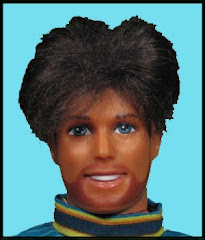Mousetrap (TM) is such a complex, Rube Goldberg-type contraption that it was actually designed by Rube Goldberg (or at least was inspired by one of his drawings). It has roughly two dozen separate, readily identifiable parts any one of which, if removed, disables the device. For instance, remove the red ball, and grandpa stops leaping face first into an empty tub wearing a 1920’s bathing suit. And if you can’t laugh at grandpa, what fun is he? It certainly appears to be irreducibly complex.
But the trap can be built up from the simple cage to the complete, functioning machine through a series of gradual additions, each the result of random mutation, each slightly improving its ability to send those cute, adorable little plastic mice to their doom. It doesn’t have to be designed all at once. Here’s how it could evolve:
Begin with the cage. This only traps the mice who wander in looking to feed at the cheese wheel. Eventually, the mice will evolve into a “pusher” species that simply pushes the cage away to get at the cheese. The cage must adapt.
Step 1: A base that is anchored in the board and limits the distance that the cage will move.
Step 2: A tall, widely visible, cheese-colored post to attract mice from greater distances.
Step 3: A round, heavy tub appears on the base. This could have several functions; for instance, a counterweight to the cage would add stability, and would provide a catch-basin for fresh water to attract the mice.
Step 4: A barrier to funnel the mice toward the cheese.
Step 5: A diving board provides the equivalent of a hamster wheel to attract more mice.
Note: By this point the mice are evolving a fear of the orange cage. Further changes in the trap will better enable it to drive mice toward the cage despite this trepidation.
Step 6: A nightmarish-looking stairway leading down to the cheese wheel. Any mouse wandering around here will be led into the danger zone like a teen-ager in a slasher movie.
Step 7: An attractive, cheese-colored bucket that tips over when the mice check it out, dumping them down the stairs into the death zone.
Step 8: A steel ball in the bucket which rolls down at the mice in a Raiders Of The Lost Ark scenario, furthering the efficiency of the stairway to hell.
Step 9: A chute connected to the barrier added in step four that prevents the damn ball from rolling off the table under the couch or wherever the fuck it always ends up.
Step 10: A big, weird-looking thing with three hands to confuse the prey; might also function as one of those stupid, pointless yet impressive things that attracts mates (plenty of examples of that in nature).Step 11: A post at the end of the chute that further slows down the steel ball, and signals the organism that the ball is no longer in the starting position (sort of like the pain that accompanies a kick in the groin).
Step 12: A big rubber ball on top of the post; it rolls off the hand and lands hard on the game board, causing the mice to scurry and panic and emit adorable little shrieks of terror.
Step 13: A chute that directs the rubber ball to land away from the metal ball, so as not to knock the damn thing under the couch again.
Step 14: A bathtub that directs the rubber ball to land on the diving board, flinging into the air any mice on the other end. Some of them will land in the cage, others will be disoriented.
Step 15: Finally, the cage migrates to the top of the post to hide from prey, giving it the element of surprise. It can not be set off easily, and many times there will be no mice to trap when it falls; still, this is better than waiting for mice that rarely enter the cage willingly.
Step 16: Grandpa evolves. Yes, he really is millions of years old. Note that this mechanism has co-opted the original purpose of the diving board. This is common in evolution.
And he links up everything from the metal ball in the bucket to the dropping of the cage; a kind of delayed fuse giving the mouse that sets it in motion at the top of the stairs time to scamper down under the cage to his demise.
There are actually a few steps still to go before the entire device is complete, and we will need to develop a symbiosis with dorky 1960’s children (like little birds that clean the teeth of alligators), but we have reached a point where we have an amazingly complex entity, featuring numerous interacting parts that can’t be removed without not only impairing the function of the whole but ripping up pieces of the board. It is “irreducibly complex” at this stage, despite having been built in steps showing incremental increases in functionality as evolution by natural selection would do. No intelligent agent is required, only heredity, random mutations, and natural selection. Which, I guess, means God vanishes in a puff of logic, and Rube Goldberg goes back to being dead. They are not needed.









No comments:
Post a Comment